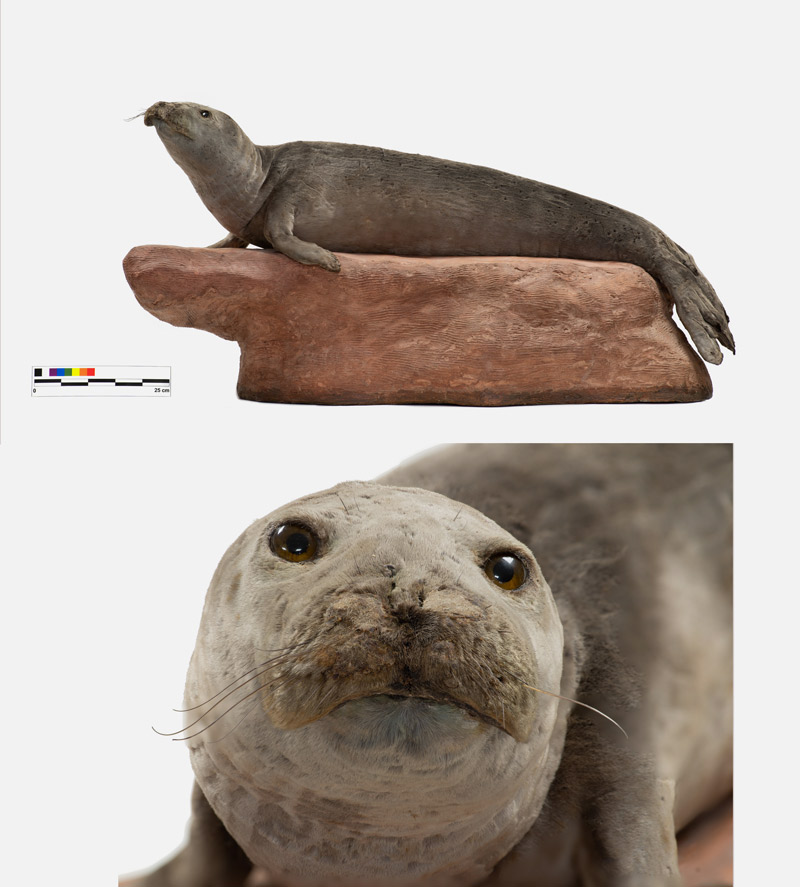Last preserved specimen of monk seal (Monachus monachus) from the Valencian coasts. MUVHNZH0125. UVMNH Collection of Taxidermized Vertebrates.
The worldwide decline of monk seal (Monachus monachus)
populations is a matter of great concern in terms of biodiversity conservation in Europe. The species is listed as Critically Endangered (CR) by the International Union for Conservation of Nature and there are several management projects underway to prevent its complete extinction. Nowadays, this species is distributed in three very isolated populations, with groups that inhabit the coasts of the Adriatic, up to Greece and Turkey, another population that appears exceptionally on the coasts of Morocco, Algeria and North Africa and, finally, the best populations are settled on the Atlantic coasts, between Madeira and the Mauritanian coast, where they are protected by special conservation programs. In total, the world population of the species is estimated at about 500 individuals.
In its adult stage, the monk seal can reach two and a half meters in length and 300 kg in weight. Their diet is mainly based on fish, cephalopods and other diverse mollusks.
The genus Monachus includes three species that have lived in recent times: M. monachus, the Caribbean monk seal (M. tropicalis), which became extinct around the middle of the last century, and the Hawaiian monk seal (M. schauinslandi), which was also present, about to disappear, if it had not been for the application of an integrated conservation plan that has guaranteed its survival.
In the past, the monk seal inhabited all the coasts of the Mediterranean and part of the Atlantic, where it gathered in groups on the beaches. However, its persecution by humans must have started many years ago, at least from the Paleolithic, as there is evidence of predation in settlements of that time. These animals’ meat was used as food and their fat or sarin was used in lighting with oil lamps, so widespread in classical times. We do not know when the widespread extermination of this species occurred, but we know that in many parts of Europe it was very rare around the middle of the 18th century. Because of this, this species was forced to change its customs and take refuge in more protected places than the beaches. The large herds that rested on the sand disappeared and this species began to inhabit the rocky coasts where it sought refuge in the caves and hollows that the cliffs and other rock formations offered them. The presence of specimens of this species became rare at the end of the 19th century, with various documents communicating the discovery of an isolated specimen and expressing the notoriety and exceptionality of the case. Over time, these news gained prominence in the press or newspapers of the time.
The image shows us a juvenile monk seal, which appeared in 1932 on the breakwater of the port of Valencia, on the rocks. The new was published in the newspaper “Las Provincias” and the treatment given to its discovery deserves to be highlighted, since the animal was baptized as a sea monster even by the fishermen and port personnel who found it. It is striking that these people, so close to life in the sea, could not recognize a seal in it and this gives us an idea of how exceptional it would be to see this species on our coasts during the first half of the 20th century.
Unfortunately, a policeman shot and killed the animal and its body was handed over to the University of Valencia for its conservation and study. The specimen was naturalized by Rafael Curats, one of the most renowned taxidermists in the city of Valencia, who had already participated in the production of specimens for the old Cabinet-Museum of the same institution. After touring various dependencies and warehouses of the University, the specimen can today be seen in the Zoology exhibition room of the current University of Valencia Museum of Natural History (UVMNH).


















